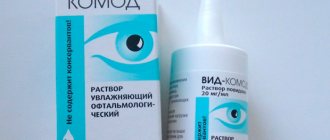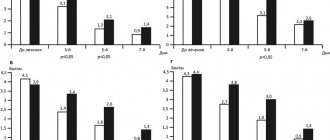Release form and composition
The drug is available in the form of eye drops 0.05%: transparent liquid, colorless or yellowish (0.4 ml in polyethylene tube-droppers: 5 tube-droppers per bag, in a cardboard pack 2, 4 or 6 bags; 10 tube droppers in a bag, in a cardboard box 1, 2 or 3 bags and instructions for use of Sigida crystal).
1 ml drops contain:
- active ingredient: naphazoline nitrate (naphthyzin) – 0.5 mg;
- auxiliary components: disodium edetate dihydrate (Trilon B), boric acid, sodium hyaluronate, macrogol 300, sodium hydroxide solution 1 M or nitric acid solution 0.1 M, water for injection.
Sigida during pregnancy and lactation
No studies have been conducted on the effect of the active component of eye drops on fetal development .
Therefore, the drug is extremely rarely prescribed during delicate periods of a woman’s life.
Treatment with an ophthalmic drug is possible only with careful weighing of all risks and threats.
If drug therapy is carried out during lactation, breastfeeding is artificially interrupted. This decision is explained by the lack of data on the ability of active substances to penetrate milk.
Pharmacological properties
Pharmacodynamics
Sigida crystal is an alpha-adrenergic agonist, a drug for topical use in ophthalmology. The mechanism of its action is due to the property of the active substance, naphazoline, to stimulate alpha2-adrenergic receptors of blood vessels and have a vasoconstrictor effect. Which helps reduce hyperemia and swelling of the conjunctiva.
Pharmacokinetics
After administration of naphazoline into the conjunctival sac, the therapeutic effect occurs quickly. The vasoconstrictor effect on the mucous membranes of the eye lasts from 6 to 8 hours.
Absorption of naphazoline into the systemic circulation is possible; this often occurs when treating children and elderly patients.
Analogs
Need to know! The following eye drops are similar in their mechanism of action:
- Visine. The active ingredient is tetrizoline. Selectively affects alpha-adrenergic receptors. Spasms blood vessels, relieves swelling of the conjunctiva of the eyes. Can be used for no more than 4 days. Use with caution when taking antidepressants simultaneously. Under the supervision of a doctor, it can be used during pregnancy. Over-the-counter product.
- Polynadim. Combined drug. The main substances are diphenhydramine, naphazoline. Inhibits H1-histamine and alpha2-adrenergic receptors. It has anti-allergic, anti-edematous effects, relieves mucosal hyperemia. Indicated for inflammation of the conjunctiva of allergic origin, infectious and inflammatory diseases with the presence of an allergic component. Contraindicated during breastfeeding, pregnancy, Sjögren's syndrome, and angular-angle glaucoma. Use cautiously in case of elevated levels of thyroid hormones, arterial hypertension, and heart rhythm disturbances. Dispensed without a doctor's prescription.
- Okumetil. Combined drug. Active ingredients: diphenhydramine, naphazoline, zinc sulfate. Constricts blood vessels, as a result of which redness of the eyes is relieved, reduces signs of inflammation, and has anti-edematous, anti-allergic, antiseptic effects. Used for inflammation of the mucous membrane of the eyes of various origins. Not applicable if you have a history of epilepsy, pheochromocytoma, diabetes mellitus, bronchial asthma, or pathology of the cardiovascular system. Conditions for dispensing from pharmacies - without a prescription.
- Alomide . The active ingredient is lodoxamide. Blocks histamine receptors, resulting in a decrease in swelling and redness of the eyes. Indications for use are conjunctivitis of various origins. During therapy, wearing soft contact lenses is not recommended. Possible combination with glucocorticosteroids. Prescription drug.
- Spersallerg . Combined drug. The main substances are antazoline, tetrizoline. The effect of the drug is similar to that of Sigida Crystal eye drops. Used to reduce symptoms of eye irritation. Use with caution during pregnancy and lactation. Over-the-counter product.
Contraindications
Absolute:
- angle-closure glaucoma;
- age up to two years;
- hypersensitivity to the components of the drug.
Sigida crystal eye drops should be used with caution in case of glaucoma, keratoconjunctivitis sicca, severe cardiovascular diseases (including coronary heart disease, arterial hypertension), prostatic hyperplasia, pheochromocytoma, diabetes mellitus, hyperthyroidism, porphyria, dry rhinitis, concomitant therapy with monoamine oxidase inhibitors or medications that cause an increase in blood pressure (BP), as well as during pregnancy and breastfeeding.
Side effects
Keep in mind! The following adverse reactions are possible when used:
- From the organ of vision : itching, pain reaction in the eye area, reactive swelling and redness of the mucous membrane, pupil dilation, increased intraocular pressure, dryness of the nasal mucosa;
- From the cardiovascular system : changes in heart rhythm (tachycardia), pain in the heart, arterial hypertension;
- From the nervous system: increased sweating, trembling, cephalalgia, drowsiness, dizziness, agitation.
Sigida crystal, instructions for use: method and dosage
Sigida Crystal eye drops are intended for topical use by injection into the conjunctival sac.
To carry out the procedure, you should take the dropper tube in your hand and, holding it in a vertical position, turn and separate the valve. After instilling the required amount of the drug into the conjunctival sac, the eyes should be carefully closed (without blinking) for several minutes so that the drug is completely absorbed into the mucous membrane. To prevent drops from entering the nasal cavity through the nasolacrimal duct, it is necessary to press the inner corner of the closed eyelid with the bend of your finger.
Do not touch the tip of the dropper to the eye or other surfaces to prevent infection of its contents.
The procedure is carried out in compliance with antiseptic rules.
The amount of the drug in the dropper tube is sufficient for one instillation procedure in both eyes. Remains of the drug and the tube after administration of the drug should be disposed of.
Recommended dosage:
- children 2–6 years old: 1 drop 1–2 times a day;
- children and adolescents over 6 years of age, adult patients: 1-2 drops 2-3 times a day.
The duration of treatment is 3–5 days.
If after two days of using the drug Sigida Crystal there is no improvement in the condition or there is a worsening of symptoms of irritation or hyperemia, pain in the eye, blurred vision, you should immediately stop the procedure and consult a doctor.
Reviews
Natalya, 33 years old:
With the onset of flowering season, a full bouquet of allergy symptoms appears. Sigid drops help to escape from allergic conjunctivitis. Already 5 minutes after the administration of the liquid, the swelling of the eyelids and redness of the whites disappear. The very convenient form of packaging allows you to always carry the medicine with you and use it as needed in any place.
Dmitry, 29 years old:
I work as a programmer, which involves spending a lot of time in front of a computer monitor. The mucous membrane of the eyes is often irritated, the whites turn red, which generally creates the appearance of an unhealthy person. The doctor recommended Sigida Crystal drops. The look becomes fresh literally after the first use of the product.
After administration of the solution, there is no burning or stinging, which often happens with other medications. The achieved effect lasts up to 8 hours; a single use is enough for a work shift in the office.
special instructions
Mydriasis may develop during the use of Sigida crystal.
Before using the drug, it is recommended to consult a doctor, especially when treating children and the elderly.
If a visual inspection of the solution reveals turbidity or a change in color, the tube with drops should be discarded.
Direct contact of eye drops with contact lenses should not be allowed, therefore, before each procedure, it is recommended to remove contact lenses and after 15 minutes put them back on the cornea.
In case of coronary heart disease, arterial hypertension and other severe cardiovascular diseases, pheochromocytoma, metabolic disorders (diabetes mellitus, hyperthyroidism), concomitant therapy with monoamine oxidase inhibitors and other drugs that can increase blood pressure, before using Sigida crystal, patients should compare the expected benefit and potential risk from therapy.
Violation of the recommended dosage regimen may cause redness of the eyes.
If irritation or redness of the eyes is caused by such serious diseases of the organ of vision as chemical injury to the cornea, infections, foreign bodies, then you should consult a doctor.
Immediate consultation with a doctor is required if intense pain in the eyes, redness of the eyes, sudden appearance of floating spots in front of the eyes, headache, rapid loss of vision, pain or double vision in bright light appear during the use of Sigida Crystal.
For epidermal endothelial corneal dystrophy (Fuchs' dystrophy), eye drops should not be used.
Impact on the ability to drive vehicles and complex mechanisms
Immediately after the administration of the drops, temporary visual disturbances are possible; during this period, you should avoid driving vehicles and performing other potentially hazardous activities.
Additional recommendations
Important! When using, please remember that:
- For local use only;
- If there is no improvement in the condition within 72 hours after the first use, then you need to contact a specialist;
- Direct interaction with contact vision correction devices should be avoided;
- Do not touch the tip of the dropper tube to any surface to avoid infection of the solution;
- Therapy for children 2-6 years old is carried out under the close supervision of an ophthalmologist;
- Frequent use may lead to hyperemia of the conjunctiva of the eyes;
- If eye hyperemia is associated with infectious and inflammatory eye diseases or foreign body entry, then you should consult a doctor;
- These eye drops are not recommended in the presence of corneal dystrophy;
- Use is appropriate for mild irritation.
Drug interactions
With the simultaneous use of Sigid Crystal with tricyclic antidepressants, the vasoconstrictor effect of naphthyzine may be enhanced.
It should be taken into account that when combined with monoamine oxidase inhibitors or using the drug within the first 14 days after their discontinuation, there is a risk of developing a hypertensive crisis.
When concomitant therapy with other local ophthalmic agents is recommended, an interval of 15 minutes between procedures is recommended.
Indications for use
Sigida is used in ophthalmology as a mono-drug for the treatment of secondary hyperemia in the manifestation of allergies, or is included in complex therapy to eliminate infectious eye diseases that occur in acute or chronic form (including allergic and pollinous conjunctivitis).




